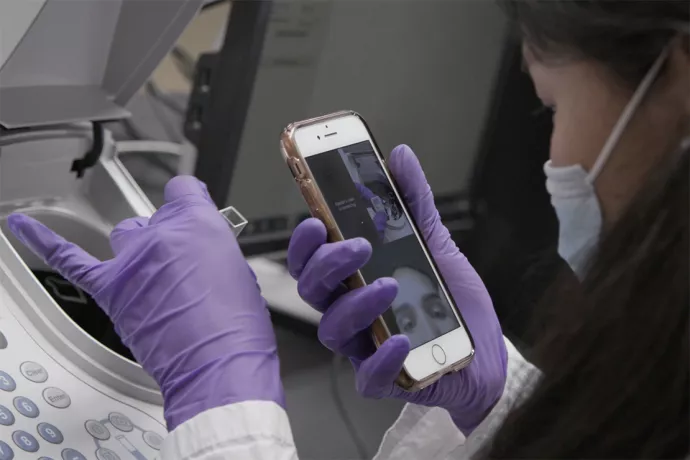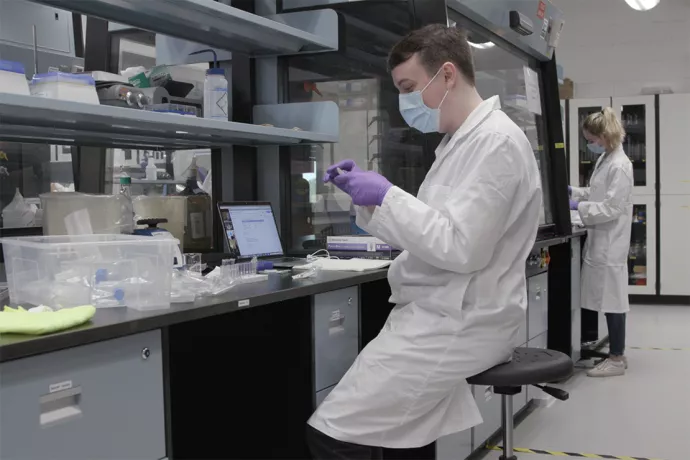
Safety protocols and creative solutions allowed UTM’s MBiotech students to learn in-person during pandemic
When the pandemic forced learning online, U of T Mississauga Master of Biotechnology Director Leigh Revers was faced with a difficult decision: cancel mandatory in-person labs over the summer and send students home for the year or find a safe way to open the labs.
Shutting down the labs would’ve meant there would be no class of 2022, Revers says.
There were early suggestions that the course move online, but after careful consideration and a great deal of thought and planning, the decision was made to run the labs in person with strict safety protocols.
The 37 students in the class were divided into teams of five, as they would have been in the past. Instead of working together as a group in the lab, though, only one member from each team was permitted in the lab during a session. Working in a relatively large space, the students could spread out to conduct their work. Revers says the rule was simple: no team member could attend two consecutive sessions, noting students were encouraged to fairly distribute lab time between team members.
Every student was provided with a locker, which was physically distanced from other teams, and inside each locker was PPE, including appropriately sized gloves and lab coats for the individual student. Revers says they either used conventional lab coats, which were laundered every week, or plastic disposable aprons, depending on the lab.
Physical distancing labels were placed on the floor and anyone entering the lab, which has a maximum occupancy of 10, had to sign in and out for tracking and tracing purposes.
There was a lot of coordination and “everyone got their name on everything,” Revers says. “We labelled everything in sight.” Even individual bottles of hand sanitizer, which were provided, were labelled with a student’s name. “We wanted to make everyone feel it was done at a professional level and it was very carefully thought out.”

The Wi-Fi in the lab was upgraded and phone stands were provided so students working in the lab could Zoom with their teammates. That communication was critical because the experiments were continuous and there was need for hand-off after each session, Revers explains.
He and his team also tried to find ways to promote some social element. Some afternoons they would order in Tim Hortons and take a coffee break outside. Markings were also placed on the floor to accommodate the mid-day session change, when teammates were arriving and leaving and might take a moment to talk to one another at a distance.
“That’s something not to be discounted. It’s not just about coming to the lab, it’s about seeing each other,” Revers says.
Alex Ognjanovic, a student in Revers’ class, says the first week was difficult because it was novel, but it soon became second nature.
“It really did work,” he says. “I was surprised because when I think of lab and teamwork, I think of everyone being there.”
He adds that he felt safe in the labs not only because of the procedures put in place, but also because everyone was doing their part to put safety first.
Classmate Kristina Bei adds that, with a common goal to learn, she and her teammates strived to ensure everyone got an equal learning experience.
“I feel we did a good job doing that,” she says of balancing access to the lab.
Aside from learning technical lab skills, Bei and Ognjanovic say they also gained a lot of communication skills. Forced to interact remotely, students learned to guide one another through lab techniques over Zoom, providing clear and concise information, and found creative ways to connect remotely through Zoom socials.
Ognjanovic says those life skills “primed us to be successful in future.”
Bei adds that she’s very appreciative faculty and staff worked so hard to run the course despite the odd circumstances.
“The lessons learned will put us at an advantage when we enter the workforce due to the unique experience with coordinating and navigating a virtual work environment,” says Bei.
“It was definitely worthwhile and will pay off.”
